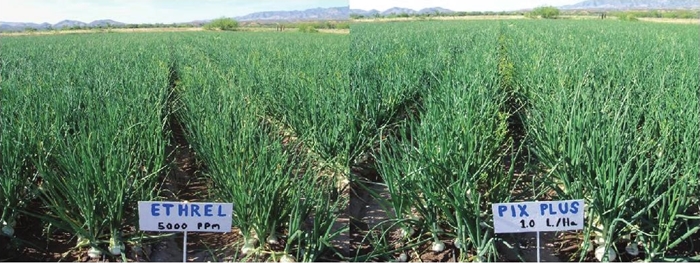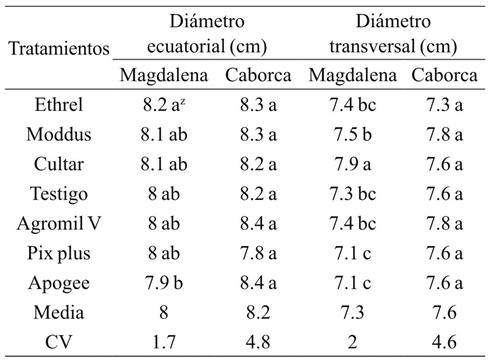Services on Demand
Journal
Article
Indicators
-
 Cited by SciELO
Cited by SciELO -
 Access statistics
Access statistics
Related links
-
 Similars in
SciELO
Similars in
SciELO
Share
Revista mexicana de ciencias agrícolas
Print version ISSN 2007-0934
Rev. Mex. Cienc. Agríc vol.8 n.7 Texcoco Sep./Nov. 2017
Articles
Evaluation of growth regulators in onion for the control of the emission of floral stem
1Campo Experimental Costa de Hermosillo-Sitio Experimental Caborca-INIFAP. Avenida S número 8 norte. H. Caborca, Sonora, México. CP. 83600. Tel. 015538718700, ext. 81105. (grijalva.raul@inifap.gob.mx; robles.fabian@inifap.gob.mx; lopez.arturo@inifap.gob.mx.
2Instituto de Ciencias Agrícolas-Universidad Autónoma de Baja California. Ejido Nuevo León, Mexicali, Baja California. (fidel.nunez@uabc.edu.mx).
The cultivation of the onion in México represents great economic importance, in the year 2014 was established 48 170 ha. The emission of floral stem represents a serious problem of production since it diminishes the quality and the yield. The objective of the present work was to evaluate the effect of growth phytoregulators on the reduction of the emission of floral stalk in onion. The experiment was developed during the autumn-winter cycle 2013-2014 in two localities (Magdalena and Caborca, Sonora). The products evaluated were: Apogee (Prohexadione Ca, 50 ppm), Cultar 25 SC (Paclobutrazol, 10 ppm), Ethrel (Etefon, 5000 ppm), Pix Plus (Mepiquat Chloride, two 42 ppm applications), Moddus 250 (Trinexapac -ethyl, two applications of 250 ppm) and Agromil V (1356 ppm). The application was done in foliar form with a volume of 500 L ha-1 for each treatment. In Magdalena, the results showed significant differences between the evaluated products in the emission of floral stem. The application of Ethrel and Pix Plus presented a positive response in the reduction of the floral stem with 10.5% against 30.7% of the control. On the other hand, Ethrel producedthe highest yield with 61.8 t ha-1. In Caborca there was no response to the application of growth regulators in the floral stem emission nor in commercial yield.
Keywords: Allium cepa L.; ethrel; quality; premature flowering; yield
El cultivo de la cebolla en México representa gran importancia económica, en el año 2014 se establecieron 48 170 ha. La emisión de tallo floral representa un grave problema de producción ya que merma la calidad y el rendimiento. El objetivo del presente trabajo fue evaluar el efecto de fitoreguladores de crecimiento sobre la reducción de la emisión de tallo floral en cebolla. El experimento se desarrolló durante el ciclo otoño-invierno 2013- 2014 en dos localidades (Magdalena y Caborca, Sonora). Los productos evaluados fueron: Apogee (Prohexadione Ca, 50 ppm), Cultar 25 SC (Paclobutrazol, 10 ppm), Ethrel (Etefón, 5000 ppm), Pix Plus (Cloruro de Mepiquat, dos aplicaciones de 42 ppm), Moddus 250 (Trinexapac-etil, dos aplicaciones de 250 ppm) y Agromil V. (1 556 ppm). La aplicación se realizó en forma foliar con un volumen de 500 L ha-1 para cada tratamiento. En Magdalena, los resultados mostraron diferencias significativas entre los productos evaluados en la emisión de tallo floral La aplicación de Ethrel y Pix Plus presentaron una respuesta positiva en la disminución del tallo floral con 10.5% contra 30.7% del testigo, Por otro lado, Ethrel produjo el mayor rendimiento con 61.8 t ha-1. En Caborca no hubo respuesta a la aplicación de los reguladores de crecimiento en la emisión de tallo floral ni en rendimiento comercial.
Palabras clave: Allium cepa L.; calidad; ethrel; floración prematura; rendimiento
Introduction
In México during 2014, an area of 48 170 ha of onion (Allium cepa L.) was established with a production of 1 368 183 t, with an average yield of 29.8 t ha-1, being Baja California, Guanajuato Tamaulipas, Chihuahua and Puebla the main producing states (SIAP, 2014). The onion is a biannual plant that requires low temperatures to induce flowering; this is an undesirable phenomenon in commercial production as it competes with the formation and growth of the bulb, which causes economic losses for the producer, decreasing the profitability of the crop. To avoid or reduce it, it is necessary to know for each cultivar the appropriate planting season that combines the photoperiod to bulbify, in addition to avoiding or diminishing, as far as possible, that the low temperatures stimulate flowering. In the induction to flowering the genotype, plant age and environmental factors interact.
In the onion four stages are distinguished during floral development: stage of the juvenile period, stage of floral differentiation (requiring vernalization), appearance of inflorescence and development of the scape. Each of these stages is influenced in different ways by the intrinsic conditions of the plant and the environmental conditions, and within these the most important are temperature and photoperiod. The onion is a kind of qualitative requirement of vernalization reason why the induction of the flowering by low temperatures is decisive, whereas the photoperiod plays an important role in the process of elongation of the escaped, which is promoted by long days.
The response to the action of low temperatures varies with the cultivars. Those that adapt more to cold areas need more cold hours, while those that grow in warm areas, require a relatively short time with low temperatures to flourish. There are also cultivars capable of flowering without the need for low temperatures. For each cultivar there is a critical bulb size, from which the period of low temperatures to induce flowering becomes minimal, this value is from 100 to 150 g for the cultivar Senshuki and from 30 to 35 g for Sapporoki (Guiñazu, 1996).
On the other hand, it is known that small plants are not able to receive the floral stimulus given by the low temperatures. For the cultivars Valcatorce INTA (long day) and Blanca Chata INTA (short day), there is a juvenile state (period in which the plant is unable to receive the low temperature stimulus for floral differentiation), which culminates when the plant reaches a diameter of the pseudostem at neck level between 6 and 8 mm. Likewise, at a higher diameter of the pseudo stem at the time of receiving the low temperatures, the shorter the period necessary to achieve the formation of floral buds. In addition, plants grown with high levels of nitrogen need a longer cold treatment than those growing with low nitrogen content. It is known that the optimal temperature for the formation of floral buds on onions is 9 °C, below or above this value, the periods of induction are longer (Guiñazú, 1996).
Valadez (1989) indicates that, in order to emit the floral stem, the onion needs to pass through a period of vernalization after the juvenile phase (bulbs larger than 2.5 cm in diameter) and that this period of low temperatures can be from 7 °C to 12 °C for four weeks. However, Sarly (1958) cited by Valadez (1989) mentions that with temperatures of 10 ºC to 15 ºC vernalization can be manifested, although it is necessary to clarify that this phenomenon depends on the cultivar and the winter temperatures, because at higher temperatures of 20 ºC does not present the flowering.
In the valley of Delicias, Chihuahua are planted in winter varieties of short photoperiod and in spring of intermediate and long photoperiod, being the winter onions that reach the highest yields, with plantings from the 15 to the 31 of October and the most outstanding are Early White Grain and Early Suprime. Sowings that occur before this period reduce commercial yields from 15 to 50% and produce from 20 to 80% of bulbs with floral stem emission (Lujan, 1991). For this reason a successful production of onion depends on a good selection of varieties in terms of photoperiod, bulb characteristics, temperature and other environmental factors of a given region (Voss, 1979).
A practice that can reduce the problem of premature flowering is the use of growth regulators, particularly those belonging to the group of growth retardants such as Paclobutrazol, Proexadione de Calcium, Daminozide and Hydrazide Maleic. The mode of action of these growth regulators is that they reduce vegetative growth by inhibiting gibberellin biosynthesis (Fallahi, 1999; Evans et al., 1999; Terry and Mille, 2000). Another growth regulator that has been used to reduce premature flowering is the Etefon whose mechanism of action is to liberate ethylene inside plants accelerating maturation and inhibiting flowering (Marrero, 2004; Ashraf et al., 2010).
Applications of Paclobutrazol at doses of 20 to 40 ppm have reduced premature flowering by increasing the diameter of bulb on onion (Ashrafuzzaman et al., 2009). On the other hand, with applications of Daminozide and Hydrazide Maleic in doses of 3 000 ppm and 150 ppm respectively, they have had the same effects.
The application of ethephon at doses of 5 000 ppm has been the growth regulator most used to reduce premature flowering and increase bulb size. The results obtained by different authors indicate a reduction of up to 22% of the problem (Cantliffe et al., 1978; Corgan and Izquierdo, 1979; Winkler et al., 1990)
Other products that can be used and where there is no previous research on its effect on the emission of floral stalk in onion are Trinexapac-ethyl which is a growth inhibitor and is applied in wheat to reduce sugar and delay flowering (Grijalva et al., 2012). At the same time, applications of vegetative growth biostimulants such as Agromil V containing different phytohormones and vitamins could be another alternative. For all products the most appropriate moment for the application of the products is when the onion bulbs have a stem neck diameter between 0.9 and 1.6 cm (Corgan and Izquierdo, 1979).
The issue of floral stalk is a problem that affects the production and quality of the onion in Mexico, estimating the damage up to 30%, which varies according to the climatic conditions and the date of planting (Macías and Grijalva, 2005). For this reason, the present work was investigated whose objective was to evaluate the effect of six growth regulators on the emission of floral stem (ETF).
Materials and methods
Description of the study área
The evaluation was carried out in two locations (Magdalena de Kino and Caborca, Sonora) the autumn-winter cycle 2013-2014. The Magdalena de Kino region is located at 30° 51’ 12’’ north latitude and 110° 21’ 28’’ west longitude at an altitude of 884 meters above sea level. The average annual evaporation of the region is 1 493 mm, the average annual temperature is 19.4 °C, the coldest month is January with a monthly average of 1.8 °C and the hottest month is June with 37.8 °C (INIFAP, 1985; Ruíz et al., 2005). The region of Caborca, Sonora, is located at 30° 42’ 55’’ north latitude and 112° 21’ 28’’ west longitude at an altitude of 200 m. The average annual evaporation of the region ranges from 2 400 to 2 700 mm, the average annual temperature is 22 °C, the coldest month is January with a monthly average of 4.6 °C and the warmest month is July with 40.2 °C (INIFAP, 1985; Ruíz et al., 2005).
Soil characteristics
In the locality of Magdalena, the evaluation was established in a soil whose main characteristics are: sandy crumb texture, electrical conductivity of 1.2 dS m-1, alkaline pH of 7.8 and an organic matter content of 0.7. In Caborca, the soil used presented a crumbly sand texture, electrical conductivity of 2.4 dS m-1, alkaline pH of 7.7 and an organic matter content of 0.8.
Agronomic management
In both localities the variety “White Grain” was used. Planting of the seedlings took place on 4 October and was transplanted on 10 December 2013. In the Caborca region it was planted on 15 September and transplanted on 18 November. In the first locality, the transplant was performed in rows 0.92 m apart with four rows of plantation (335 000 plants ha-1) and fertilized with the formula 210N-100P-60K. In the second locality, the transplant was performed in furrows at 1 m separation with double row of plantation (224 375 plants ha-1) and the fertilization used was 180N-80P. In both localities the pressurized irrigation system (drip) through which the fertilization to the crop was applied was used.
In order to control weeds in both localities, a trifluralin (1 kg ha-1) was applied with a pre-transplant grafting step and two applications of oxyfluorfen (250 g ia ha-1) the first before the transplant and the second 40 days later. The only pest that was presented was Thrips (Thrips tabaci) and Lamda-Cyhalothrin (42 g ia ha-1) was applied for its control. The rest of the practices were performed according to the recommendations of Macías and Grijalva (2005).
Treatments evaluated
In both locations six treatments were evaluated: Apogee 27.5% (Prohexadione-Ca), Cultar 25 SC (Paclobutrazol), Ethrel 240 (Ethefon), Pix Plus 4.2% (Chloride Mepiquat), Moddus 25% (Trinexapac-ethyl) Agromil V 77.8% and the control without application. For the application of the products, first a stock solution was prepared with the concentrations mentioned in Table 1, after which 500 L ha-1 of this solution was applied for each treatment. The application was done in foliar form except Cultar which was applied to the soil at the base of the plants and was incorporated with the irrigation water.

Table 1 Treatments evaluated to reduce the incidence of emission of floral stalk onion (ETF) at two locations.
In the town of Magdalena, the quimic products were applied on March six when the crop had a plant height of 49 cm, a stem diameter at the base of the soil of 1.4 cm and seven true leaves. Whereas, in the locality of Caborca, the application was realized the 26 of February with a height of plant of 37 cm, a diameter of stem of 1.3 cm and seven true leaves. The second application of the Pix Plus and Moddus products took place on 9 and 20 March in Caborca and Magdalena respectively.
Characteristics evaluated and statistical analysis
The variables evaluated were: floral stalk emission percentage, floral stalk yield loss, bulb weight, bulb diameter, yield and plant height. The experimental design was randomized blocks with four replicates. The size of the experimental plot was 24 m2 and the useful plot of 8 m2. For the separation of means was used the Tukey test at 0.05 probability. Analysis of variance and means tests were performed using the UANL statistical package (Olivares, 1994).
Results and discussion
Emission floral stemp and performance loss
In the locality of Magdalena, the harvest was realized the 20 of May, whereas in Caborca it was carried out the 14 of May. The floral stalk emission and yield losses presented statistical differences (p≤ 0.05) only in the Magdalena region. In the first locality, there was a greater variation in the percentage of stems emitted in the different treatments. The highest percentage of stems was presented in the control without application with 30.7% and the best response in the reduction of floral stem corresponded to the application of Pix Plus and Ethrel which decreased this physiological problem to 10.5%. In the locality of Caborca the percentage of emission of floral stem varied from 25.3% to 16.7% (Table 2).

z= medias con la misma letra dentro de cada columna son estadísticamente iguales (Tukey 0.05).
Table 2 Emission of floral stem and reduction in yield by emission of floral stalk in onion with the application of different growth regulators.
The locality of Magdalena, is a region colder than the region of Caborca and the results obtained indicate that the application of Pix Plus and Ethrel (Figure 1) in this region can be a good alternative to reduce the problem. On the other hand, this answer coincides with the results obtained by Cantliffe et al. (1978); Corgan and Izquierdo (1979); Winkler et al. (1990), who mention that the use of Ethrel reduces the problem of premature flowering onion, contrary in the locality of Caborca, the applications of the growth regulators did not affect the ETF. In general, the floral stem emission was slightly higher in the region of Caborca than in Magdalena (21.6% versus 19.5%, respectively) (Table 2).
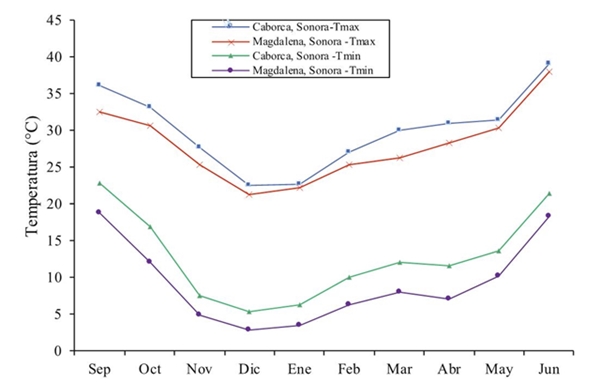
Figure 1 Maximum and minimum monthly temperaturas recorded in the autumn-winter cycle 2013-2014 in the regions of Caborca and Magdalena, Sonora.
The onion requires cool to cold temperatures that coincide with the beginning stage of bulb filling to emit the floral stem, which occurs in the months of february and march and these conditions of temperature and plant size were presented in both locations (Figure 2). On the other hand, the temperature in general was lower in the region of Magdalena whereby the crop response to the application of the growth regulators in relation to the locality of Caborca was possibly presented. In general, the problem of floral stem was slightly higher in Caborca due to the fact that in this locality in the critical stage of temperature (februarymarch), the crop presented a greater size and development of plant due to planting date and transplant earlier than in Magdalena, which is a condition for the appearance of floral stems.
The yield loss caused by the floral stalk emission was higher in the control without application in both localities with 16.1 and 14.2 t ha-1 in Magdalena and Caborca respectively. In the first locality there were statistical differences between the products applied, corresponding lower values to the Ethrel and Pix Plus treatments with 5.6 and 5.3 t ha-1 respectively, representing a reduction in the yield reduction of around 66% with respect to the yield loss in the control. In general, the production affected by the presence of floral stalk was 10.9 t ha-1, representing 17.7% of the total average production harvested per hectare. In the second locality, there were no statistical differences between the evaluated products, but in general, in the locality of Caborca the reduction in production by floral stem was of 12 t ha-1 which in general represents 18.5% in yield loss.
Yield and plant height
The application of growth regulators affected the yield (p≤ 0.05) only in the Magdalena region. The higher commercial yield was inversely proportional to the floral stalk emission and yield loss. The higher yield, the lower floral stem emission and the lower yield loss. Among these, the application of Ethrel was the one that obtained the highest yield with 61.8 t ha-1, followed by Moddus and Pix Plus with 56.8 and 52.5 t ha-1, respectively, against 49.9 t ha-1 of the control (Table 3). In this regard, in an evaluation on onion growth regulators, Dios (2008) mentions that yield was 14.3 t ha-1 higher with the application of Pix Plus in relation to the control.
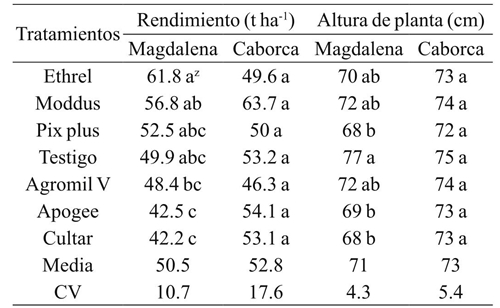
z= medias con la misma letra dentro de cada columna son estadísticamente iguales (Tukey 0.05).
Table 3 Commercial yield and plant height in onion with the application of different growth regulators.
In the Caborca region, no response was observed for the evaluated products, with yields ranging from 63.7 to 49.6 t ha-1, with an average yield of 52.8 t ha-1 (Table 3). The average yields were very similar in both regions, because in Caborca the lower planting density and the earlier planting date produced a higher growth and bulb weight, which compensated the high density established in Magdalena. At plant height, only the Magdalena region presented statistical differences. The witness, presented the highest height with 77 cm and the smaller ones corresponded to Pix Plus and Cultar with 68 cm. The above agrees with Fallahi (1999), Evans et al. (1999); Terry and Mille, (2000) who mention that growth regulators that inhibit gibberellin biosynthesis reduce vegetative growth. In the Caborca region, there were no statistical differences between treatments in relation to plant height, with an overall mean of 74 cm versus 71 cm in Magdalena (Table 3).
Bulb weight
No statistical differences were detected in bulb weight of commercial onions in both regions; however, the statistical analysis of bulb weight with floral stem problem detected significant differences among treatments evaluated in the Magdalena region. The commercial bulb weight was higher by 30% in the locality of Caborca than in Magdalena (Table 4), due to the greater growth of the bulb caused by the lower planting density established. The commercial bulb weight difference in relation to bulb weight with floral stem problem was around 25%, probably due to competition for assimilates within the plant between the bulb formation and filling processes in relation to the development of the bulb floral stem, losing its commercial quality due to the tubular structure that forms inside the bulb, which tends to present a premature decay in relation to the rest of the same in the postharvest stage (Figure 3).
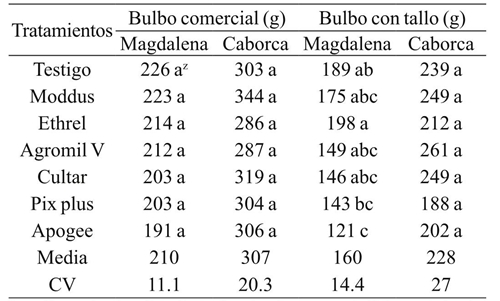
z= medias con la misma letra dentro de cada columna son estadísticamente iguales (Tukey 0.05).
Table 4 Commercial bulb weight and with onion floral stem emission with the application of different growth regulators in two localities.
Diameter of bulb
In the locality of Magdalena, statistical differences were presented in both the equatorial and transverse diameters between the evaluated treatments, whereas the locality of Caborca, the statistical analysis did not detect differences in any of the two diameters (Table 5). In Magdalena, the equatorial diameter varied from 8.2 cm to 7.9 cm; while in Caborca, the variation was 8.4 cm to 7.8 cm. In both localities, the equatorial diameter was 8% greater than the transverse (slightly flattened bulb).
Literatura citada
Ashrafuzzaman, M.; Nasrul, M. M.; Razi, M. I.; Uddin, M. K.; Shahidullant, S. M. and Meon, S. 2009. Paclobutrazol and bulb size effect on onion seed production. Int. J. Agric. Biol. 11(3): 245-250. [ Links ]
Ashraf, M.; Akram, N. A.; R. N. Arteca, R. N. and Foolad, M. R. 2010. The physiological biochemical and molecular roles of brassinosteroids and salicylic acid in plant processes and salt tolerancy. Crit. Rev. Plant. Sci. 29(3):162-190. [ Links ]
Cantliffe, D. J. and Woods, F. E. 1978. Induction of bulbing and retardation of flower stalk development in onion by ethephon, Abdel- Rahman, M. (Ed.). Proc. 5th annual meeting of plant growth regulator working group, Blacks-burg, Va. 25-29 June. 179 p. [ Links ]
Corgan, J. J. and Izquierdo, J. 1979. Bolting control by ethephon in fall planted short-day onion. J. American. Society. Hortic. Sci. 104:387-388. [ Links ]
Dios, E. M. 2008. Efecto de tres fito-reguladores de crecimiento en el cultivo de cebolla Allium cepa variedad Texas Granex 438 en el Valle de Tumbes Perú. Artículos Técnicos. http://www.engormix.com/articles-view.aspx?id=2320. [ Links ]
Evans, J. R.; Evans, R. R.; Regusci, C. L. and Rademacher, W. 1999. Mode of action, metabolism and uptake of BAS 125W prohexadionecalcium. HortSci. 34(7):1200-1201. [ Links ]
Fallahi, E. 1999. Metabolism, action and use of BAS-125W in apples. HortSci. 34(7):1192-1193. [ Links ]
Grijalva, C. R. L.; Macias D. R.; Martínez, D. G.; Robles, C. F. and Núñez, R. F. 2012. Effects of Trinexapac-etil on different wheat varieties under desert conditions of Mexico. Agric. Sci. 3(5):658-662. [ Links ]
Guiñazú, M. E. 1996. Factores de manejo que afectan la floración en cultivos de cebolla (Allium cepa L.) Edición on-line. Facultad de Ciencias. Avances en Horticultura. 1(1):1-9. [ Links ]
INIFAP (Instituto Nacional de Investigaciones Forestales, Agrícolas y Pecuarias). 1985. Guía para la asistencia técnica agrícola. Área de influencia del Campo Experimental Región de Caborca. Caborca, Sonora, México. 10 p. [ Links ]
Lujan, F. M. 1991. Técnicas para la producción de cebolla en la región de Delicias, Chihuahua. Folleto para Productores Núm. 5. INIFAP-CIFAP-CEDEL. 10-12 pp. [ Links ]
Macías, D. R. y Grijalva, C. R. L. 2005. Tecnología de producción de hortalizas, frutales y forrajes en la región de Magdalena de Kino, Sonora. Publicación Técnica Núm. 8. INIFAP-CIRNOCECAB. 9 p. [ Links ]
Marrero, P.; Peralta, H.; Pérez, Barroto, J. S. y Blanco, M. A. 2004. Efecto de las aplicaciones exógenas de ethrel 480 sobre la anatomía del tallo, en cuatro variedades de caña de azúcar (Saccharum spp. Hibrada). Caña de azúcar. 22(2):5-18. [ Links ]
Olivares, S. E. 1994. Paquete de diseños experimentales FAUANL. Versión 2.5. Facultad de Agronomía UANL. Marín, NL. México. [ Links ]
Ruíz, C. J. A.; Medina, G. G.; Grageda, G. J.; Silva, S. M. M. y Díaz, P. G. 2005. Estadísticas climatológicas básicas del estado de Sonora. (Periodo 1961-2003). Libro Técnico Núm. 1. INIFAP-CIRNOSAGARPA. 92-93 pp. [ Links ]
Sarly, A. E. 1958. Horticultura. Editorial Acme, SACI. Buenos Aires, Argentina. 93-105 pp. [ Links ]
SIAP (Servicio de Información Agroalimentaria y Pesquera). 2014. Cierre de la producción agrícola por estado. http://www.siap.gob.mx. [ Links ]
Terry, W. S. and Mille, S. W. 2000. Growth retardants affect growth and flowering of scaevola. Hort. Sci. 35(1):36-38. [ Links ]
Valadez, L. A. 1989. Producción de hortalizas. Primera edición. Editorial Limusa. 25 p. [ Links ]
Voss, E. R. 1979. Onion production in California. Publication 4097 Cooperative Extension. University of California, Davis. 6-8 pp. [ Links ]
Winkler, J. R.; Seoane, A. P. and Lara, P. F. R. 1990. Utilization of the growth regulator Flordimex in different economic crops in Cuba. 25 años de colaboración científico-técnica-Cuba- RDA-1965-1990. 22-26 pp. [ Links ]
Received: August 01, 2017; Accepted: November 01, 2017











 text in
text in 

